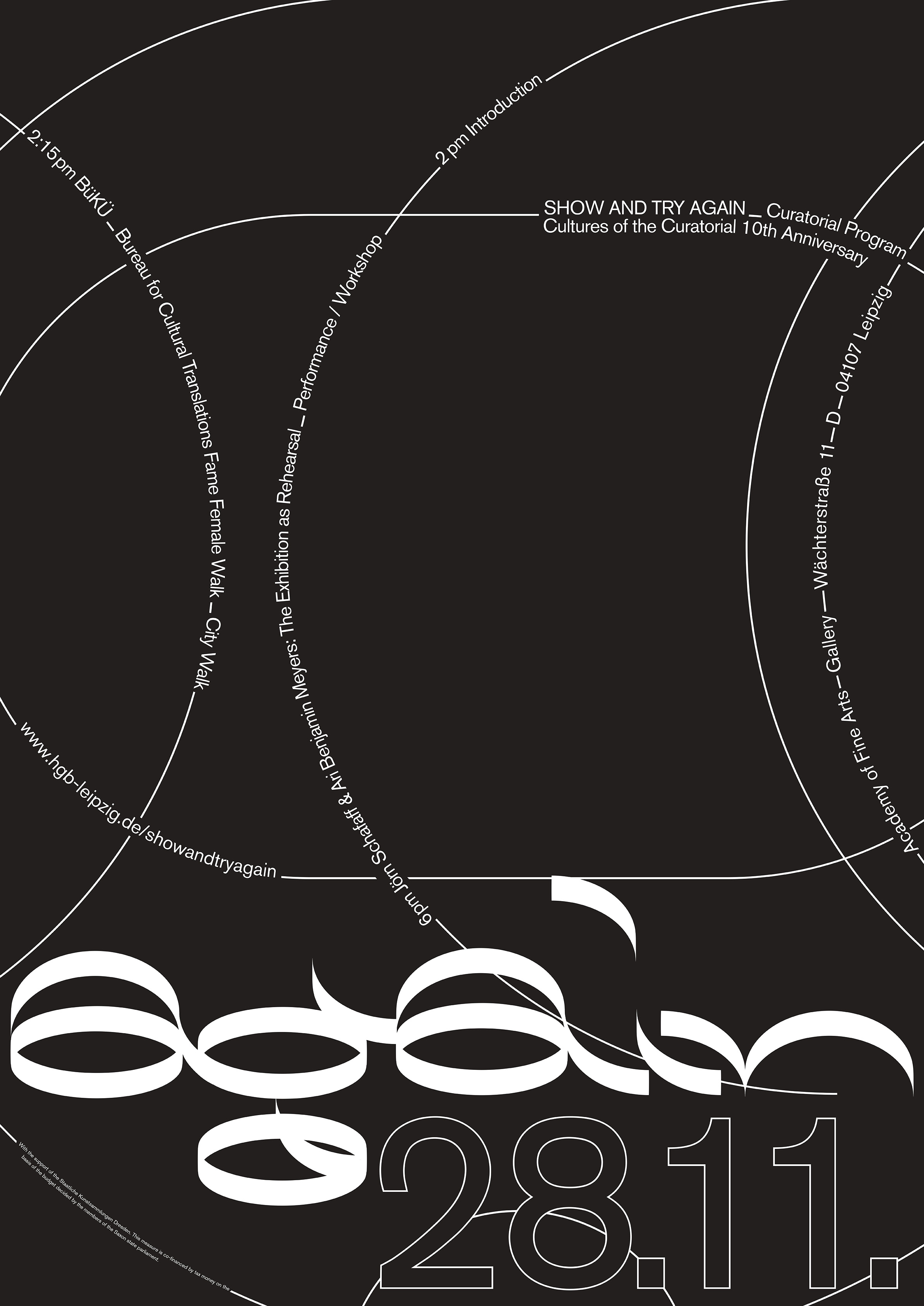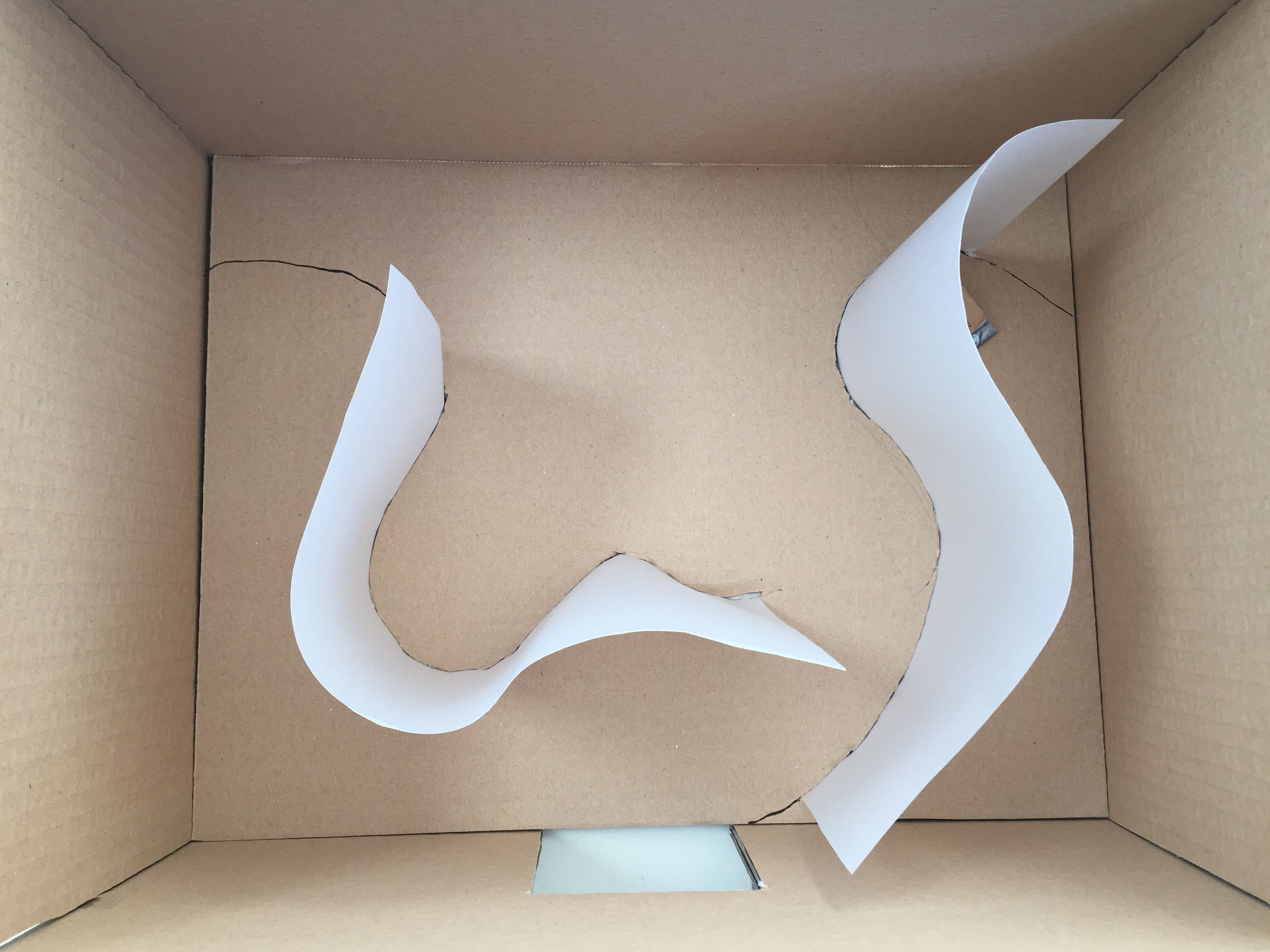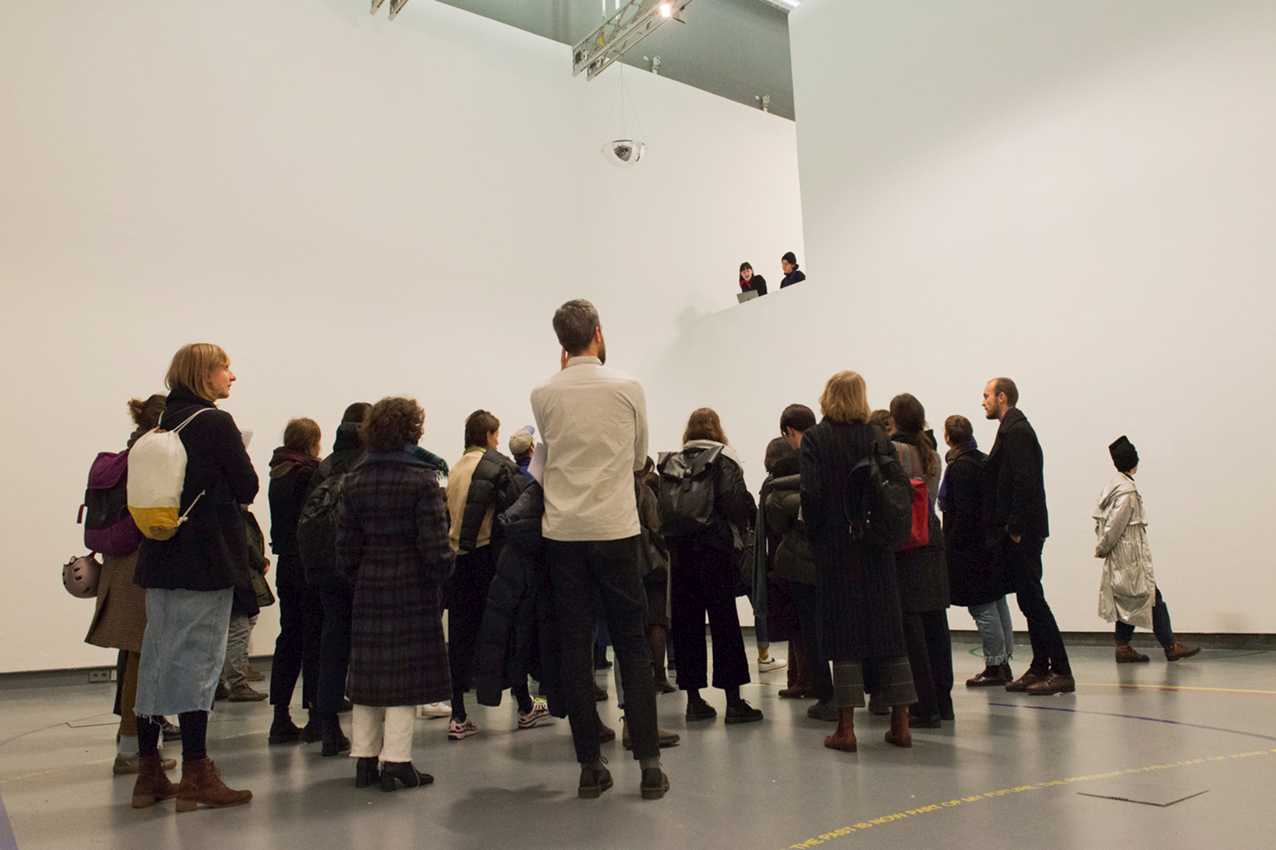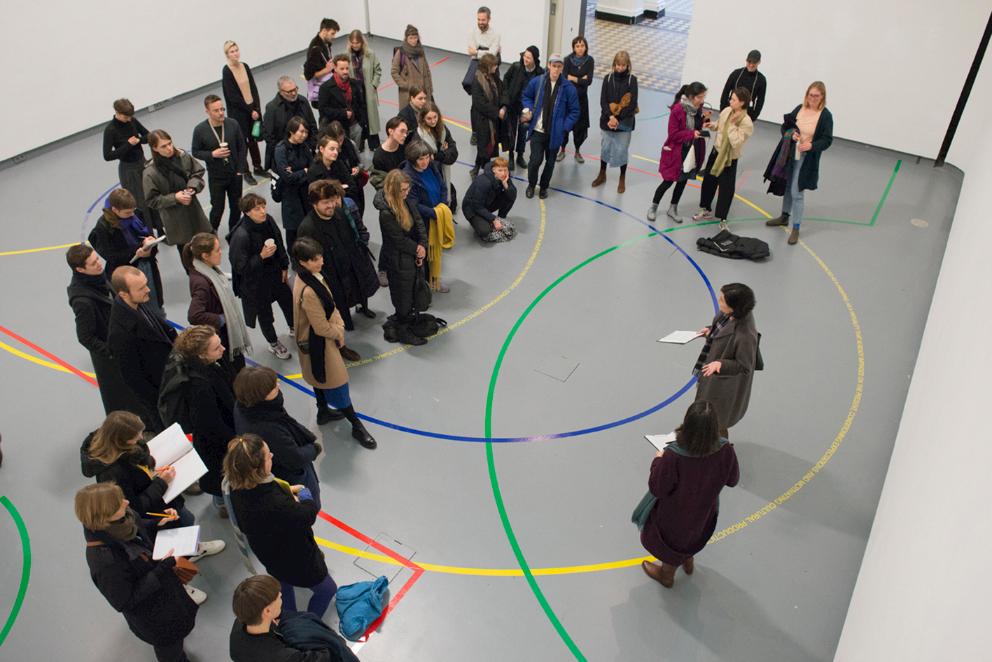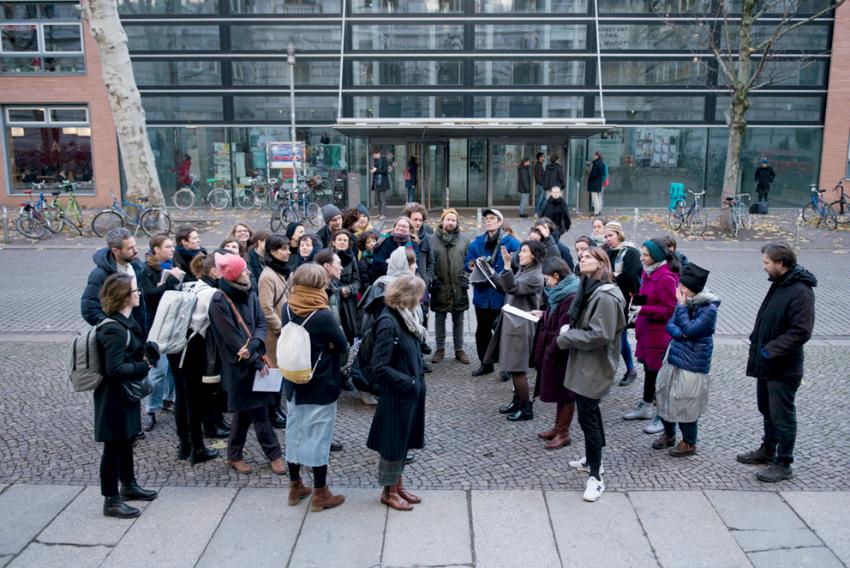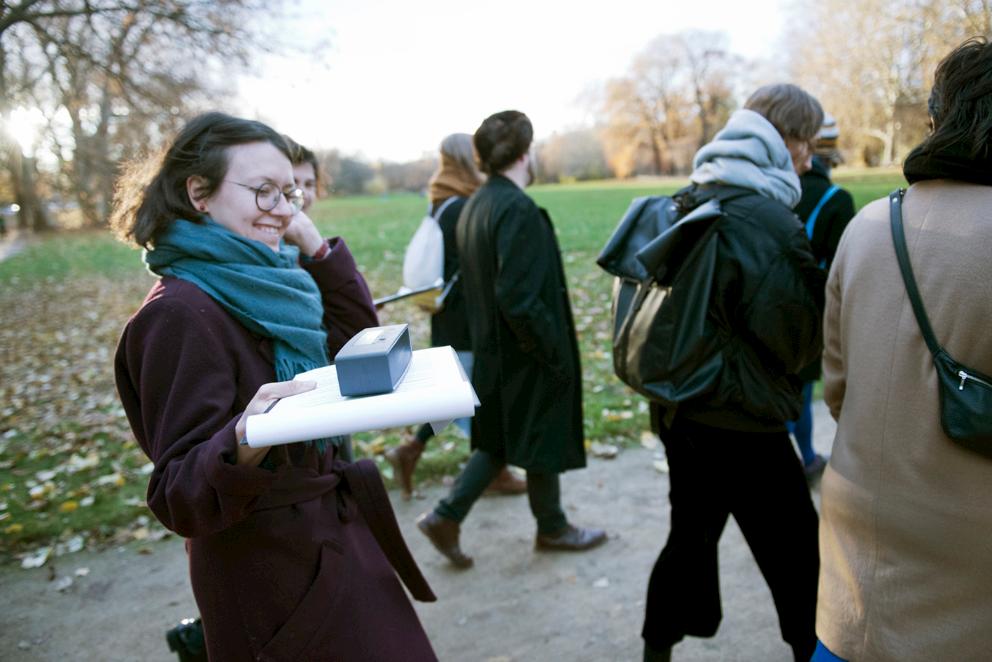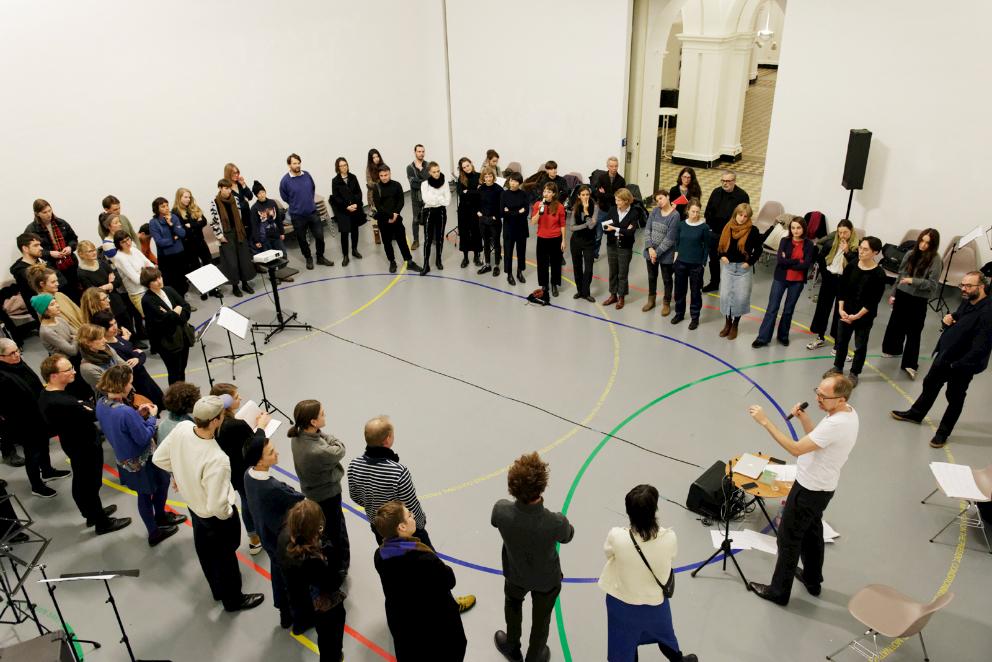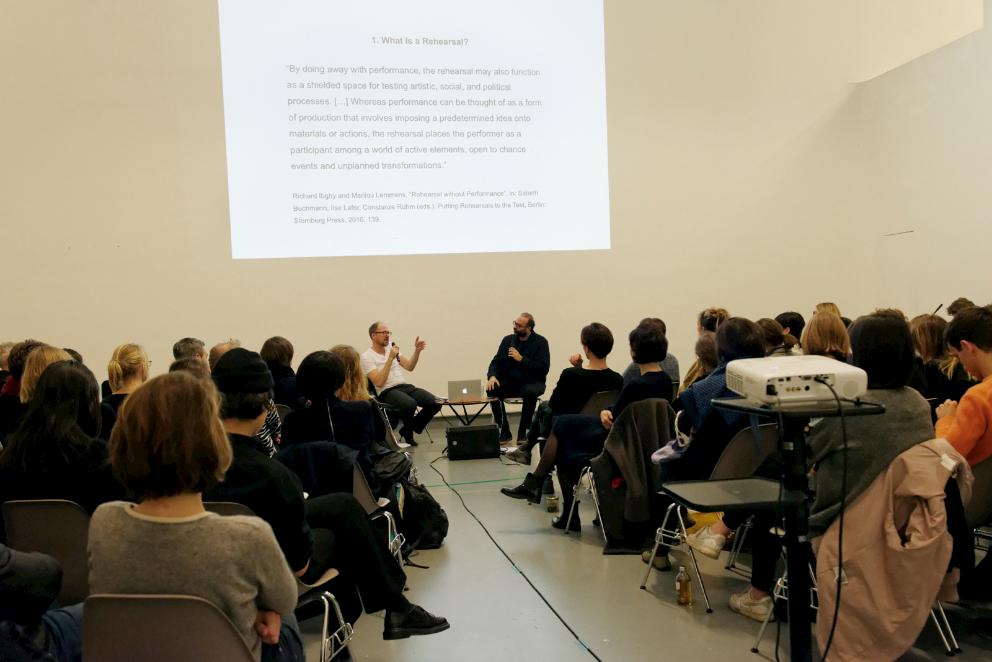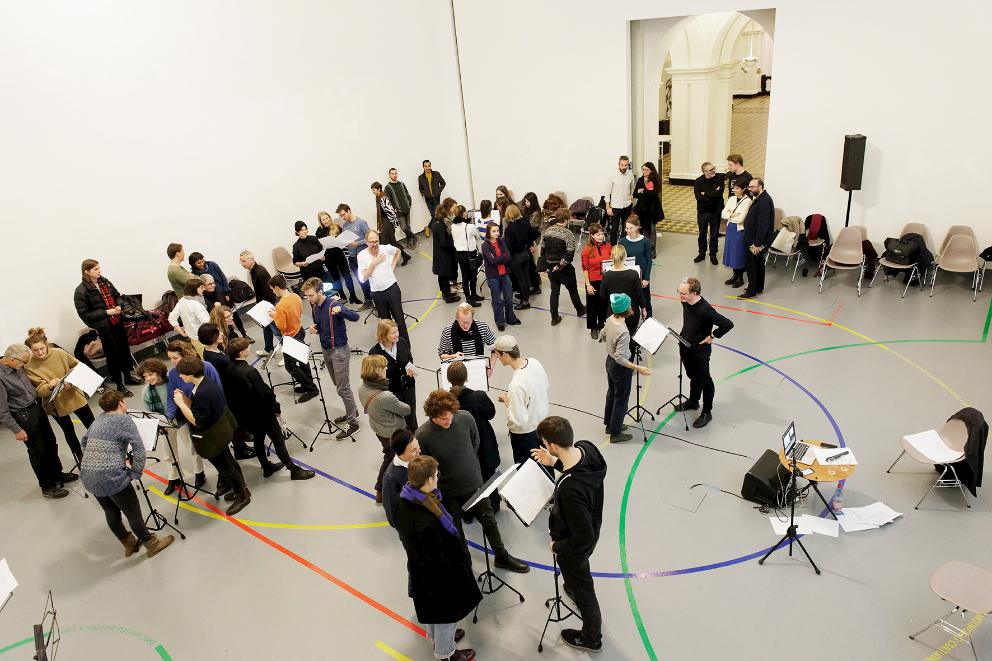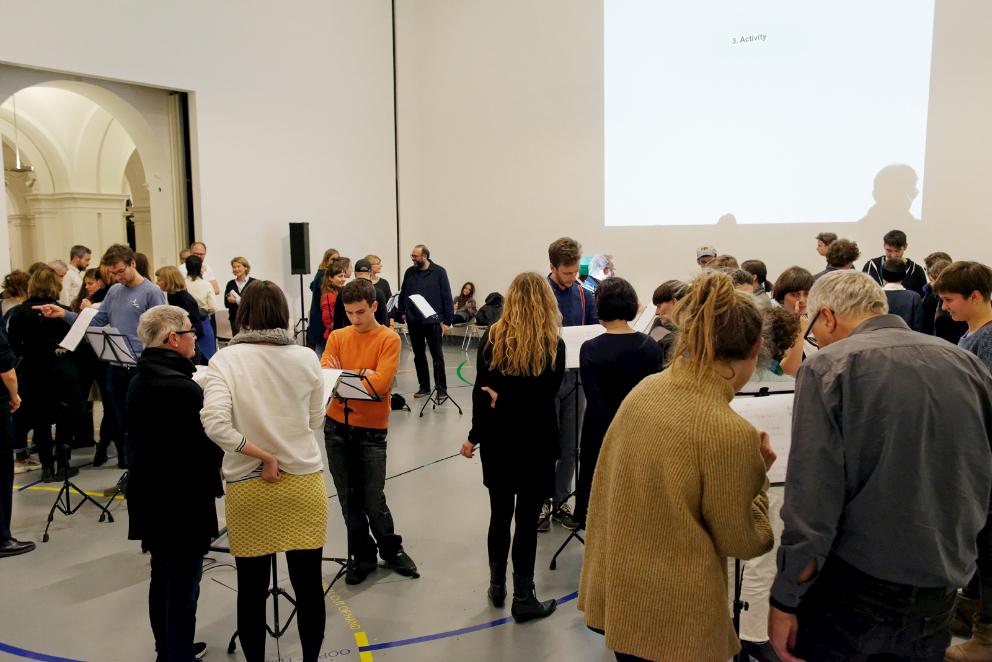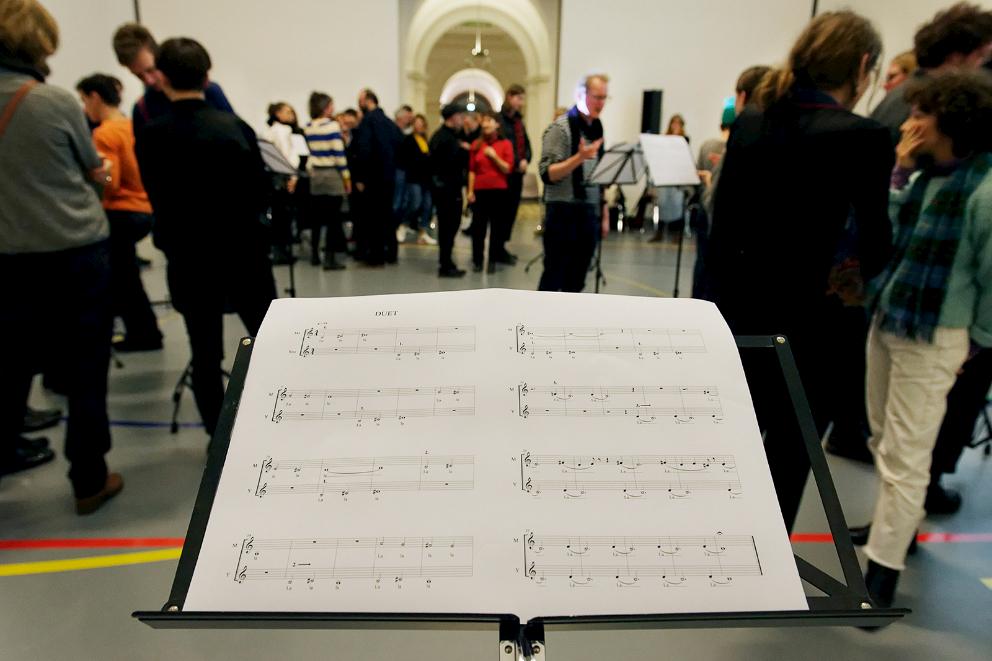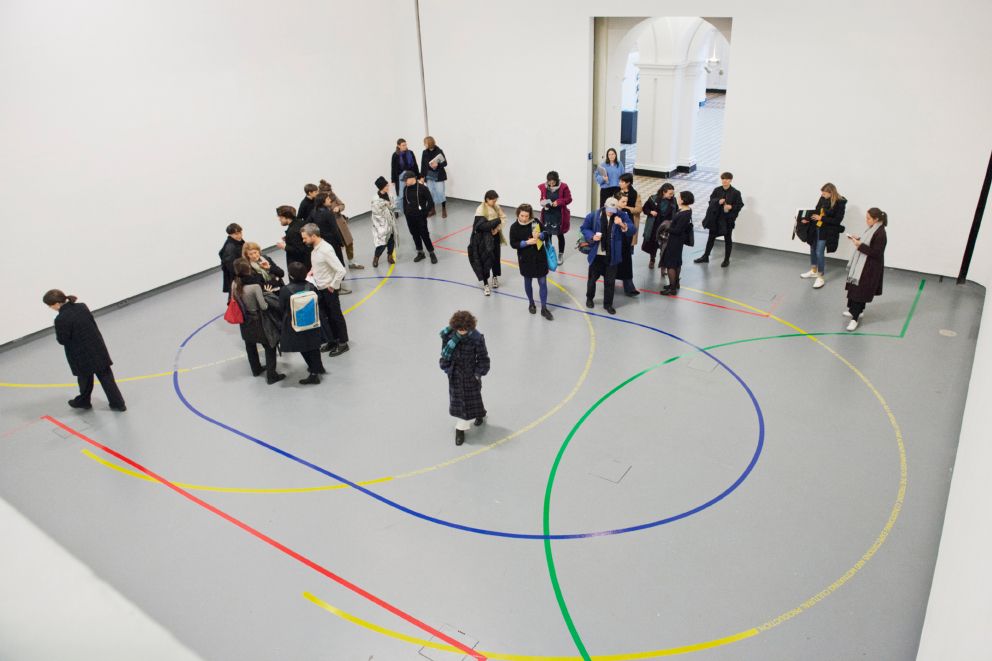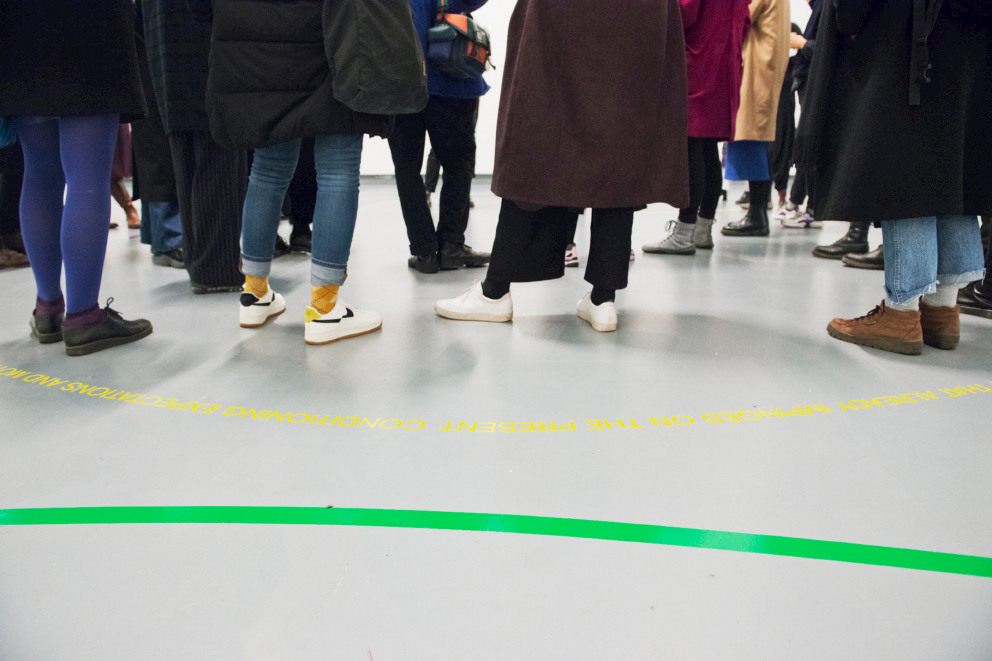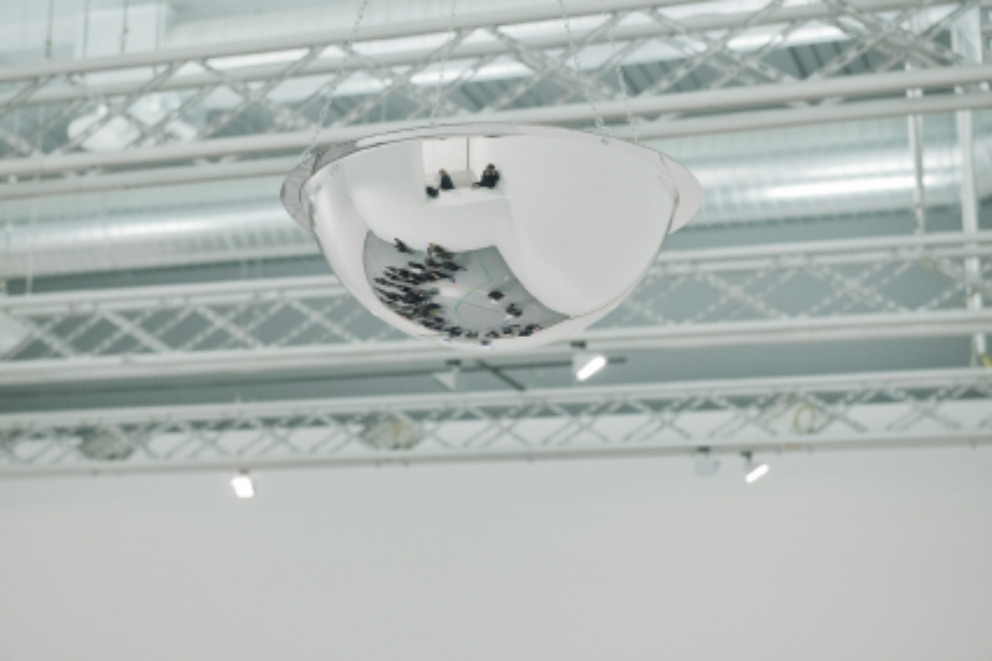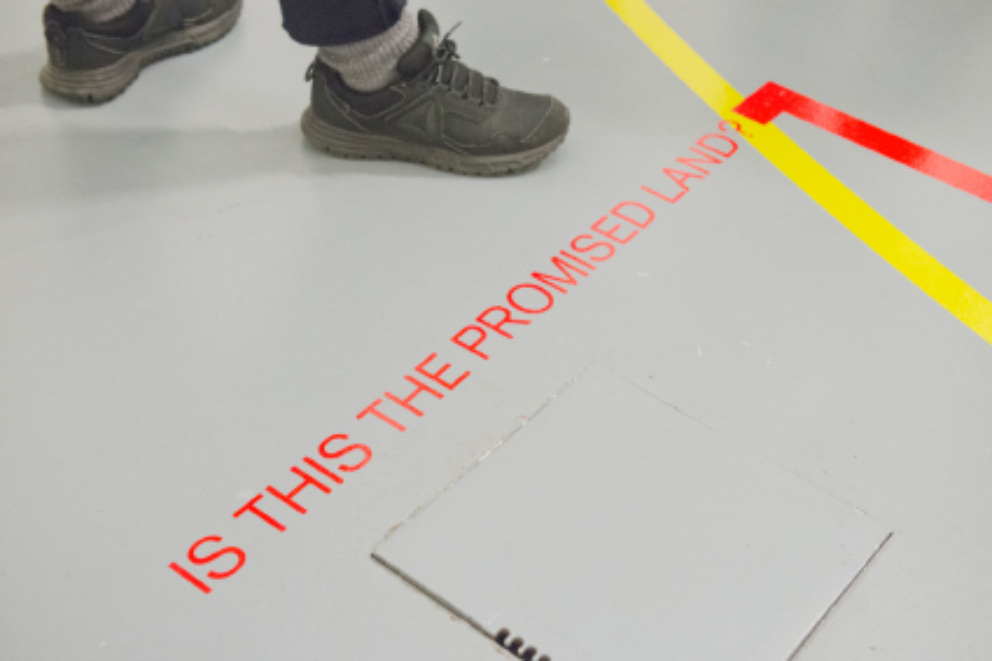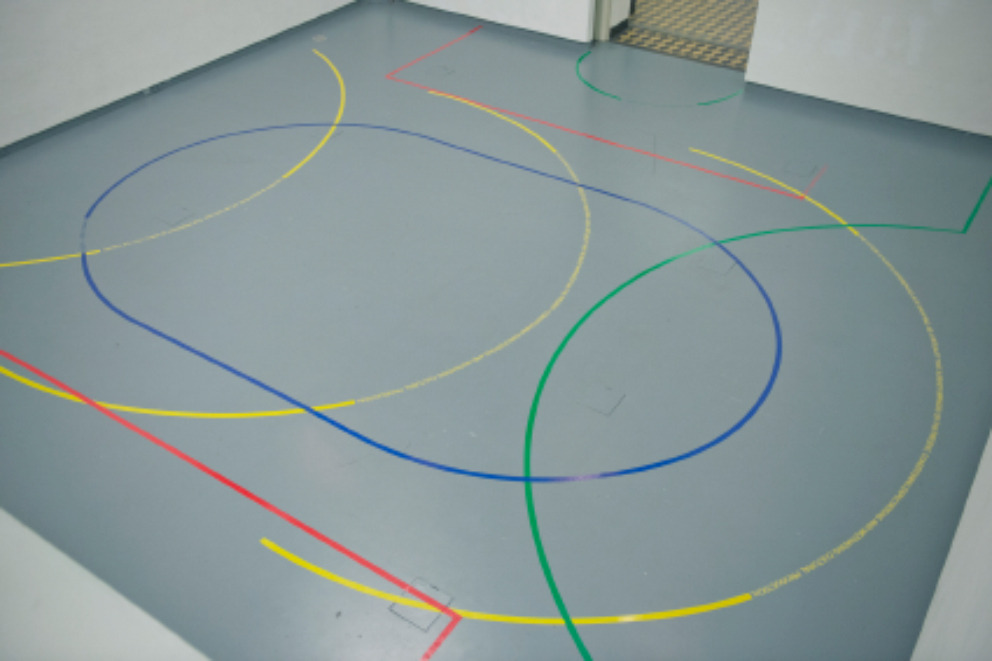asya yaghmurian
Show and try again?
Showing as non-action, as a state of being.
Treating show as a process that constantly evolves as on open space that welcomes new participants and ideas.
Accepting the neutral space and not treating the activities and knowledge as goods.
There is no ‘us’ and there is no ‘them’, there is no ‘inside’ and there is no ‘outside’.
We should talk more about art.
Trusting the process of the show, thus trusting the pause, the gap, the anarchic dimension.
Considering to not show, not try or never again.
Freeing the show, emancipating it from the structures.
Thinking about what to offer to the show and what to offer to try.
Questioning the show and questioning what do you want to show.
Finding the right addressee for the question.
Showing the try is already a show.
Showing the things that are not supposed to be shown.
Trying to show on behalf of others, the ones who don’t have the tools to assembly.
Trying to avoid the clashes of the show.
Being careful not to be stuck in the loopholes of the show.
Not bringing boredom to try again or to show.
Being careful not to cross the line between the show and the showoff.
Showing the assembly, not assembling the show.
Remembering and caring about the spectator who finally shapes the show.
Walking with the spectator through the show.
Imagining the show, as seen from non-show, assembly or try!
jana dohmann
QUESTIONING THE AFTER-SHOW
is the result of a field research—trying to capture the voices of the audience in the form of questions.
It created an archive of collected questions, that have grown out of the participation in the 5 days of Show and Try Again.
Following the approach of generating a living archive that stimulates new reflections and serves as a starting point for new discussions, this encyclopedia was translated into a game—that brings the manifold thoughts of visitors, participants, artists and initiators into motion and contact.
This format uses the active, discursive qualities inherent in the nature of the questions and tries to catalogue some of the experiences of the various participants in the program.
You are cordially invited to download the game and question the follow-up of the program-week in a playful way.
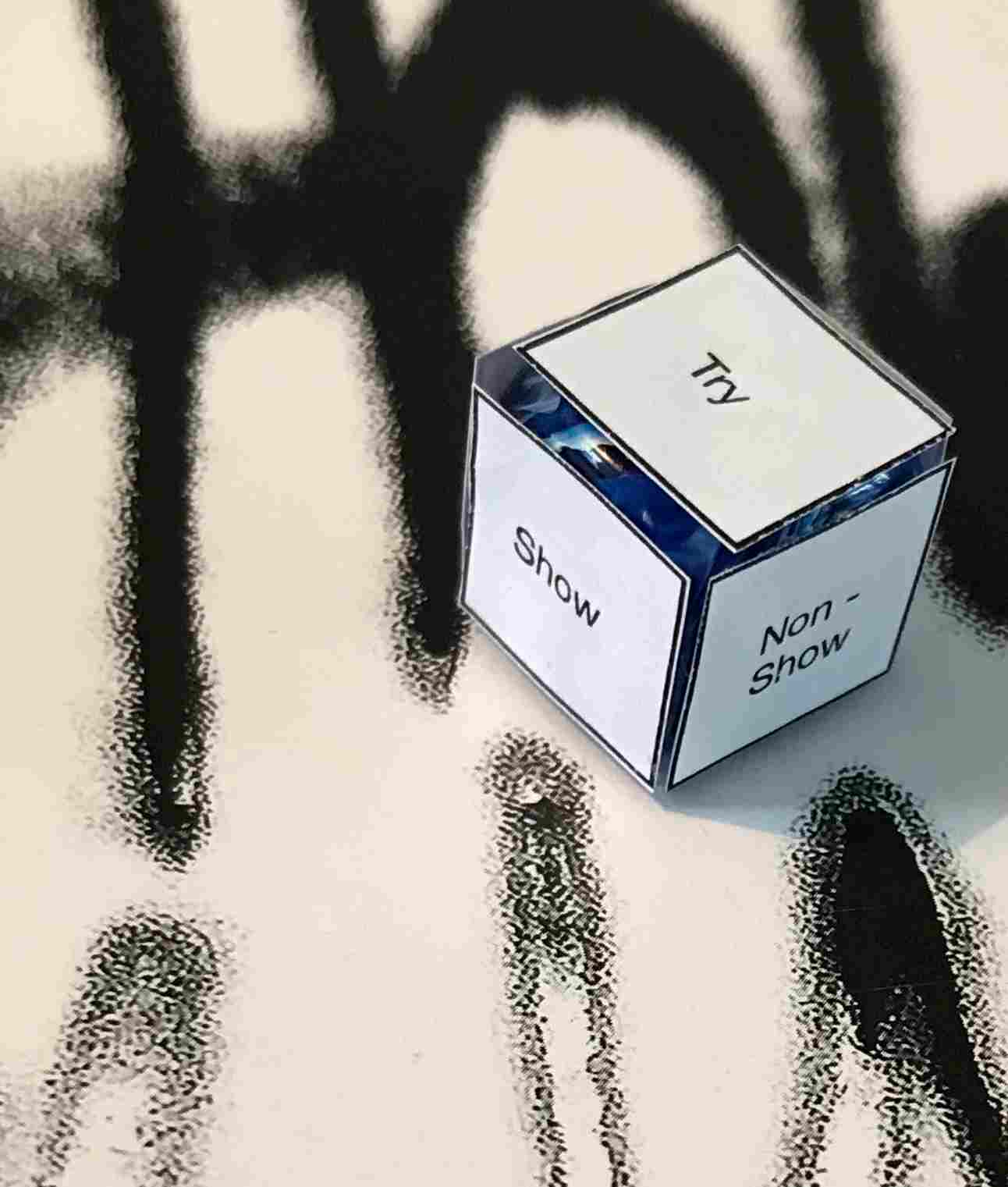
AGAIN
How can this process of re-framing lead into an ongoing oscillation between the past and the future?
What if we consider the exhibition in terms of rehearsal, a medium commonly defined by its static appeal?
And what if the rehearsal process itself is put on public display? How does that potentially change the notions of performance and rehearsal?
How would it affect our understanding of what exhibitions do, how they are processed, who is involved and in what way?
Was könnte situatives Kuratieren bedeuten?
Wie lässt sich, im Kontext des Kuratorischen, ein sozialer Raum im öffentlichen Raum einrichten?
Speaking of rehearsal as a performance/exhibition, how can it be archived?
Denkt man eine Chorprobe als öffentliche Ausstellungssituation, was passiert mit den Noten aus einer Chorprobe und welche Rolle haben sie im Nachhinein?
How to create a space where to show and to rehearse at the same time?
Wenn wir Geschichten von Frauen erzählen, die in Männerdomänen eingedrungen sind, um diese aufzubrechen, zementieren wir dann durch unsere (Wieder)-erzählungen eben diese Machtstrukturen?
Was macht eine Situation zugänglich?
Is an exhibition a yesterday or a tomorrow?
How can an exhibition involve a side for showing and trying? ‘What if the rehearsal process itself is put on display?’
Wie unterschiedlich kann ein und der selbe Raum bespielt werden?
Wie sehr beeinflussen Vorprägungen oder Erinnerungen die Wahrnehmung eines Raumes?
Muss eine Frage ‚gut‘ sein, damit sie gestellt werden darf?
What do you do when you are invited to the party but do not feel welcome?
Wie lassen sich (allzu) schnell etablierte soziale Strukturen und Rollen in sozialen Situationen dekonstruieren und neu definieren?
What are the potentials of rehearsal that we can use for the curatorial?
Was ändert Wissen? Kann Wissen alleine etwas ändern? Oder braucht es eine (dazugehörige) Handlung?
Wieviel hat das subjektive Gefühl von involviert sein Einfluss auf meine tatsächliche Teilnahme, Partizipation an einer Veranstaltung, an einem Format? Und wieviel hat mein Befinden mit der räumlichen Gestaltung einer Situation zu tun?
Wie bedingen sich geschriebenes Recht und ungeschriebene sozialen Normen gegenseitig?
Welche Vor- und welche Nachteile bringen Formate, die Theorie und Praxis in einer Veranstaltung zusammenbringen?
Inwiefern ist eine Ausstellung in ihrem Format offener oder flexibler als eine Theater- oder Tanzproduktion?
Wie lange kann man proben, bis es sich erschöpft?
Was ist die tieferliegende Ebene hinter dem Moment des ‚rehearsals‘, die wir für das Kuratorische nutzen wollen und können?
Gibt es einen Zusammenhang zwischen der physischen Position, in der man sich als ZuschauerIn während eines Vortrags befindet, und der Aufnahme des inhaltlich präsentierten?
Wo ist der Basketballkorb?
Wie kann man das Publikum in etwas involvieren, ohne das es sich dabei unwohl oder zu etwas genötigt fühlt?
Ist die Probe, durch die ihr inne liegenden Momente der Wiederholung eher eine Limitierung oder eine Erweiterung ihrer Möglichkeiten/Potenziale?
Bezogen auf die SprecherInnenrolle bei Vorträgen: Was ist das ‚stimmigste‘ Verhältnis zwischen Vortrags- & Partizipationsmomenten? Wann habe ich die Stimme, wann gebe ich die Stimme ab?
How to curate (cultural situations in) the public space?
Would have been there a possibility to manifest something in the public trough our bodily gathering?
How do you want to appropriate the (public) space?
nushin atmaca
Translating into dominant structures
Repetition—and translation is one mode of repetition—always implies a reference to the ‘original’, whether it is mentioned or not. It has the potential to change the original in a way that rips it of its dominating structures. It also has the potential to strengthen the very same structures by translating narratives, stories, and perspectives into it without questioning the normative expectations, categories and values that form these dominating structures. The question that arises thus for the curatorial is whether it can also be sufficient to show what was unseen before by telling the hitherto unheard story along the lines of widely accepting dominating narratives. Or whether the curatorial should ideally aim at dismantling and deconstructing hegemonies by telling stories and facilitating perspectives in a way that consciously questions dominant structures.
To become more concrete: What happens if women’s (or any other minorities’) lives are translated into the normative frame of a successful, outstanding, artistic life without questioning the categories which we use to measure success, being outstanding, and art? These categories were and still are mostly shaped by men—in the European case by white men—and we use them to judge whether a life can be regarded as a role model for others. By translating women’s lives into these categories we on the one hand show that women were present in male dominated institutions and environments, we shed light on their influence upon their time and contemporaries, we open up possibilities to reflect upon their legacy, and we point to structures that up until now prevent a social equity between women and men. We tell their lives in a way accessible and legible for most audiences, and thus open a space for the discussion of a social issue that is relevant and urgent in our times: the gender bias. But by the same act of translating their lives into known and accepted narratives, we miss out on questioning the categories and values that are associated with these narratives. What is actually worth telling? What about all the women that don't fit general expectations, that did not have the opportunities and the social, educational, and mostly also economic capital that ‘successful’ women had? They remain marginalized, unseen and unheard of. The stories we tell still remain male-dominated stories; not in terms of the protagonists (although, on a side-note, most of these women were only able to ‘succeed’ because they had a male gate-opener), but in terms of categories and assessments.
What does that imply for the act of translation within the curatorial field? Translating marginalized groups and their ways of life into narratives that are known and accepted helps to show that these persons actually exist, as individuals and as groups, that they lead ‘normal’ and at times successful lives. It confronts a general audience with realities that were ignored, neglected or not known. It offers room for a critique of dominant structures without deconstructing them. This strategy might be apt for reaching the biggest audience possible because it does not question the dominant world view and does not confront individuals with the role they might have in upholding discriminatory and marginalizing structures. But out of its self-understanding as a critical discipline, the curatorial should not stop there. It should look for those narratives and perspectives that are formed along other concepts of success, mastership, art, and bring them to light. It should, in the end, focus on the diversity and polyphony of human existence regardless of categories and labels used to classify them, and convey them to its audiences.
ariana graf
Change Narratives
The historical narratives of our Western society are told from the perspective of a privileged social class. It is a white, masculine and heteronormative perspective that manifests an exclusionary narrative in the past and present. In incessant loops, the dominant narrative continues in our linguistic usage and in the narration of history. It excludes other perspectives and makes them invisible.
In German-speaking countries, the exclusive use of generic masculinum is still generally valid. The ambiguous form pretends to include every gender, while talking exclusively about men. The consequence is that with intended generic use, specifically masculine speakers are nevertheless associated. In addition to form, it is also the content of narratives that creates images from a white, male, heteronormative perspective. They belong so much to our system of expectations and attitudes, to what we believe, that women* themselves accept these prejudices, behave according to them and loop incessantly. A breakout from the loops of dominant narratives can be attempted in a curatorial practice of telling previously unseen stories, perspectives and realities of life.
AGAIN
Conventional city walks symbolize the inscription of a singular narrative in the collective memory. They tell loop-like stories of well-known buildings, places and monuments. Built, occupied and in memory of those who "wrote history". In order to bring other perspectives into our field of vision, stories can also be told by groups of people who were equally involved in city life, but who are still invisible today. The potential lies in the loop as a starting point for a narrative, which, slightly changing with every repetition, evolves from the current conventional narrative as something different. At the same time, there is the danger of strengthening the stuck structures by telling further stories, but without questioning the normative expectations, categories and values. The attempt to develop a new narrative is thus always related to the dominant, established narrative, regardless of whether it is explicitly mentioned or not.
Narrations of well-known women, for example, continue to be measured by parameters constructed from a male perspective. They tell of women in heterosexual relationships with famous men and above all of women in the sense of a binary gender system. The act of reproducing their lives in known and accepted narratives fails to question the categories and values associated with these narratives. Her stories remain male-dominated stories; not in the sense of the protagonists, but in the sense of categories and judgements.
For a curatorial practice it is therefore insufficient to throw light only on the hitherto unseen within the dominant structures. Rather, it should specifically attempt to deconstruct hegemonies by telling stories from marginalized perspectives and by consciously displaying works, relating them to each other and the surrounding space.Title:

magdalena walpoth
Role(s)

Using a series of photographs that I have taken of objects that I carried with me during the event or that were used in some other way, I try to investigate the question of my personal social role as a researcher. Together with the room sketches on which I have recorded my daily movements in the HGB gallery (a kind of auto-reflective motion detector) and excerpts from the thought log that I kept on the ‘show day’, they are supposed to be a kind of hypomnemata or Individual Mythology and act as a visual notebook for the website. Through the daily repetition of the recordings, they also become Show and Try Again in the sense of a self-examination of your own perspective. This is intended to create a digital object that can be understood as making the research process visible. The texts with which I overwrite the photographs are largely taken from the definition of social role given in Wikipedia.

A role (also social role) is a set of connected behaviors, rights, obligations, beliefs, and norms as conceptualized by people in a social situation.

It is an expected or free or continuously changing behavior and may have a given individual social status or social position.

The division of labor in society takes the form of the interaction among heterogeneous specialized positions, we call roles.

Roles included appropriate and permitted forms of behavior and actions that recur in a group, guided by social norms, which are commonly known and hence determine the expectations for appropriate behavior in these roles, which further explains the place of a person in the society.

Roles are occupied by individuals, who are called actors.

When individuals approve of a social role (i.e., they consider the role legitimate and constructive), they will incur costs to conform to role norms, and will also incur costs to punish those who violate role norms.


The anticipation of rewards and punishments, as well as the satisfaction of behaving prosocially, account for why agents conform to role requirements.

Roles may be achieved or ascribed or they can be accidental in different situations.

An achieved role is a position that a person assumes voluntarily which reflects personal skills, abilities, and effort.

Roles can be semi-permanent or they can be transitory.

Roles are also frequently interconnected in a role set, that complement of role-relationships in which persons are involved by virtue of occupying a particular social status.
ewa meister
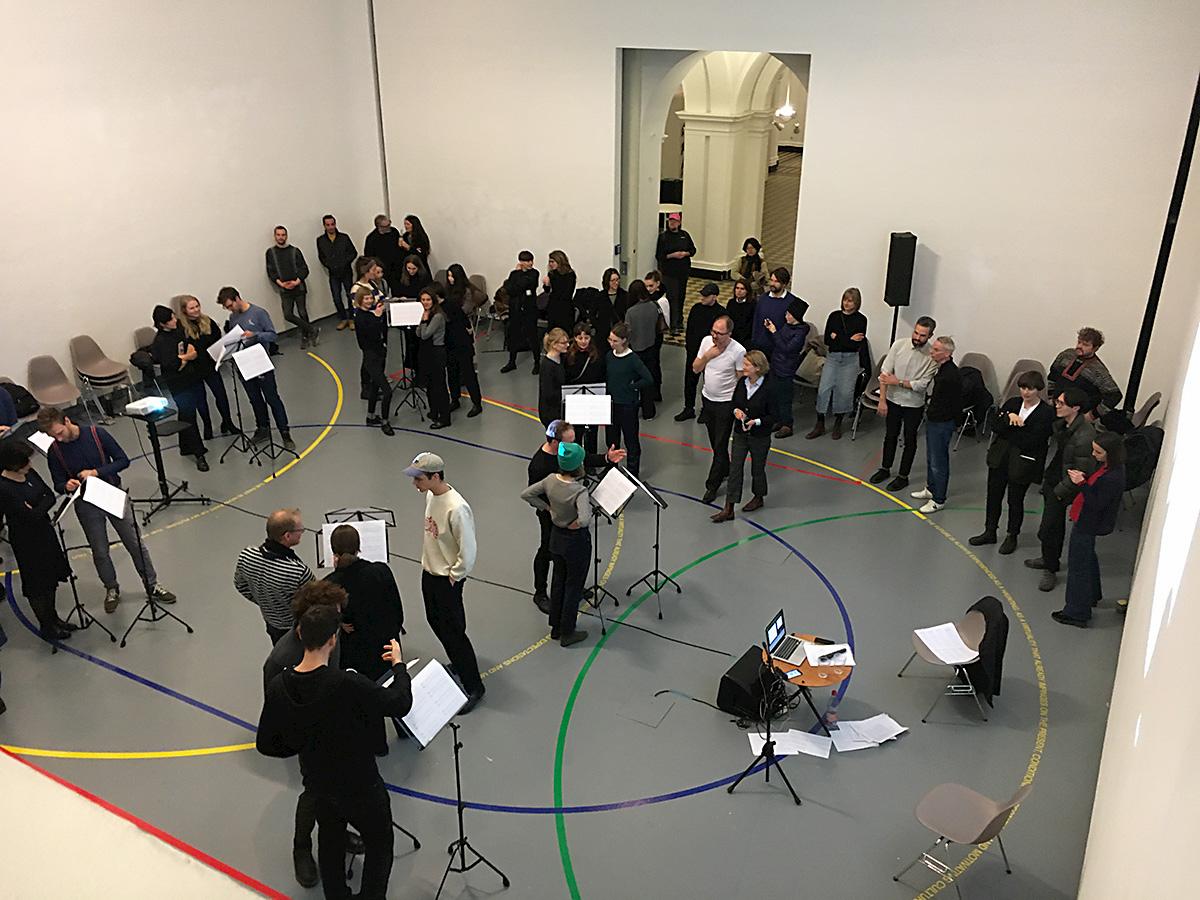
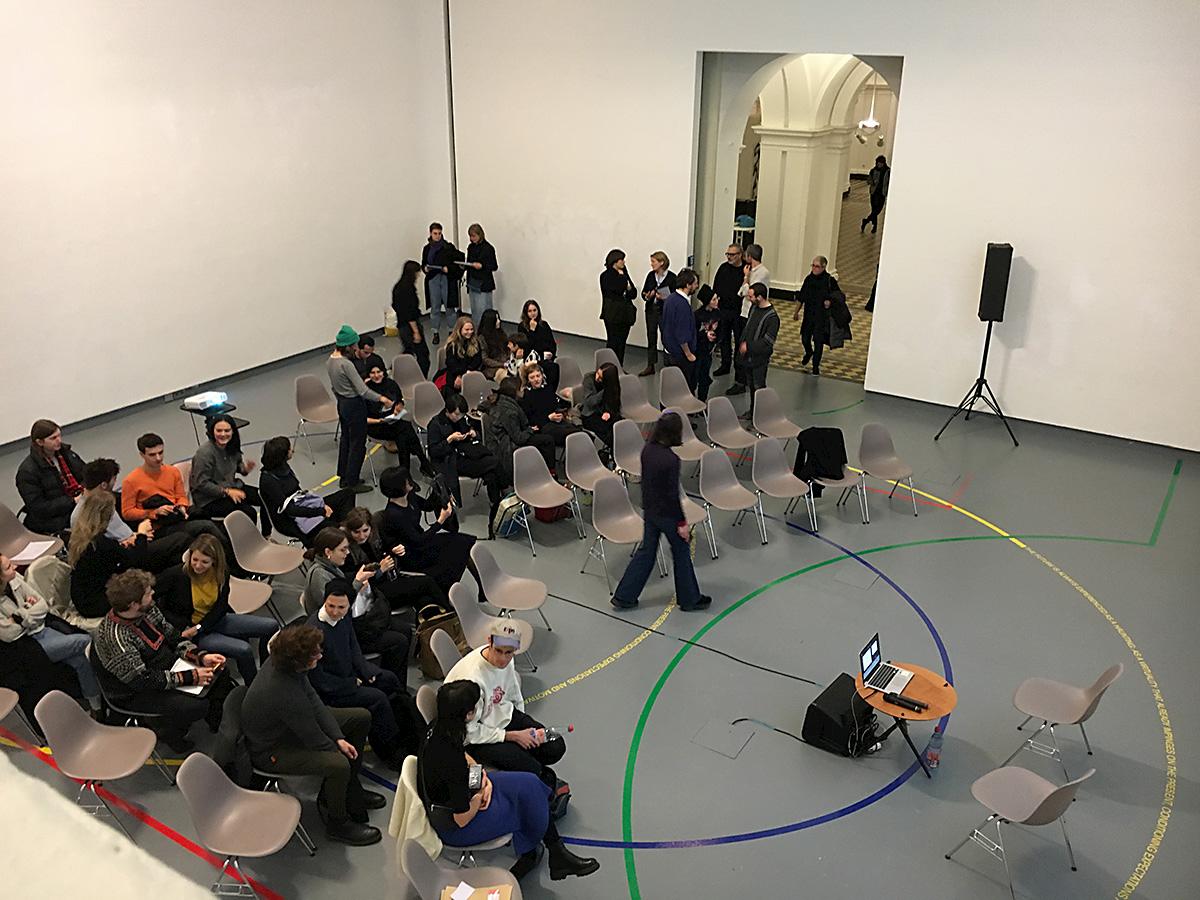
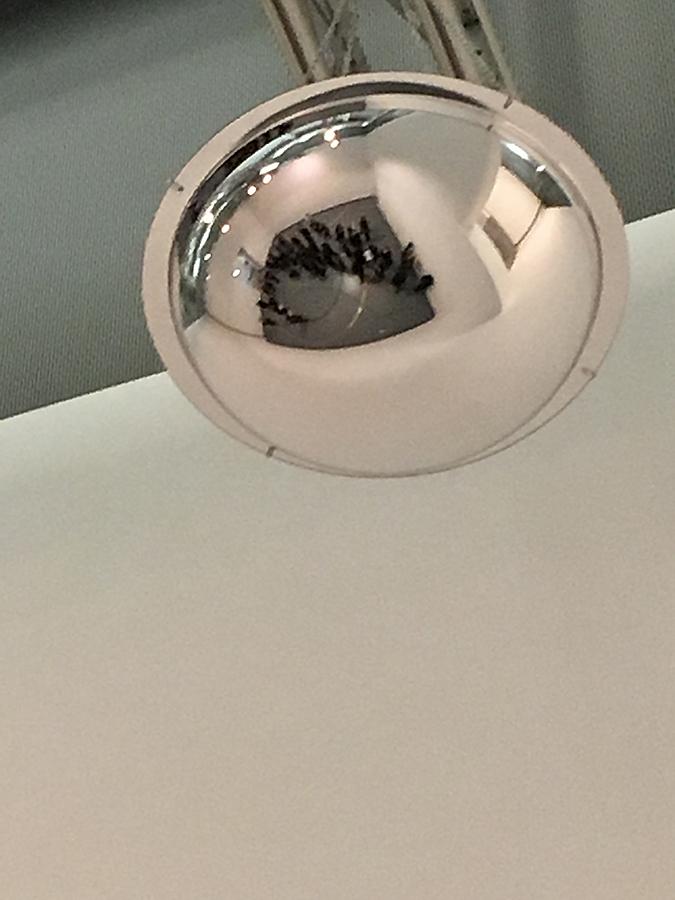
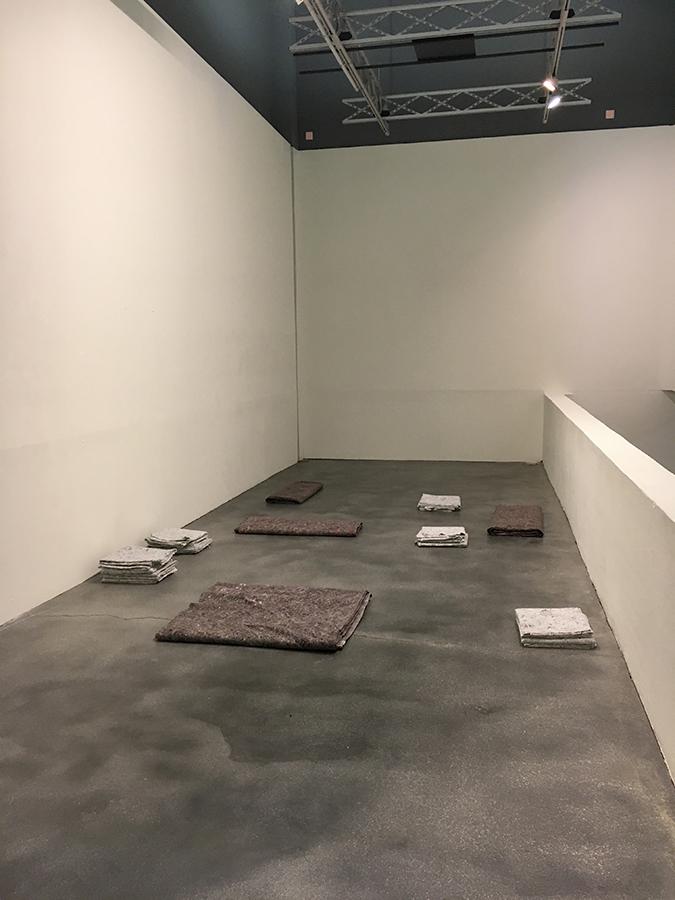
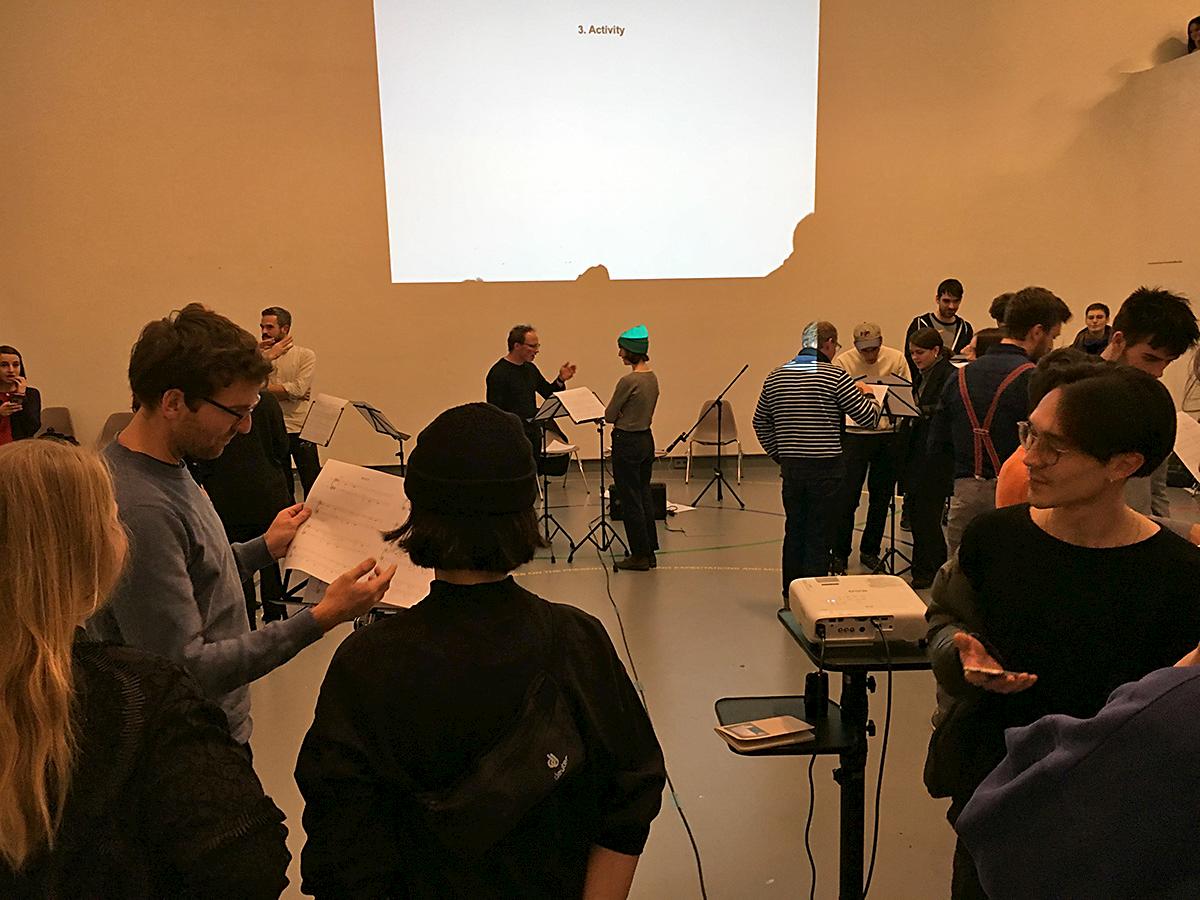
An exhibition is physical but, if done well, can be thought-provoking.
Do you think the space helped you or did not help you do engage with the content of the event?
The connection between the place, how you feel and what happens there. What makes that possible? Or in conclusion, what is prevented by different spaces?
How, through field perspective, multi-perspectivity, one could always find oneself in a different relationship to what just happened.
It was nice how we all read together on the try-day, how it came from different voices that also had different accents in English.
We are exhibited through the exhibition—for ourselves and for others.
This line between being invited or feeling forced stays very interesting.
You could just let the microphones go by, one could use it or not, but it would pass you by.
nadine vollmer
Memory Shots
29 November, 2019 7.31am
(The original version is a voice memo in German, because the memory that first came to my mind was sound and voice. The English written translation therefore lacks voice, sound, atmosphere (some distant sounds of a construction site nearby the place of recording) and the exact translation of pauses, long ones and short ones that indicate voids in memory or the time memory needed to become a thought.) La — a ___ La — a ___ La — a ____La — a ___ (and so on, voice slightly ascending with the first a, then rapidly descending to the second a, please ask Ari Benjamin-Meyers in case you’d like to see the score)__________________________________________________________________ _______________________________ 29 November, 2019 ____ 7.31am__________________ ______________________ I remember the moment of relief when ___ Jörn Schaffaf and Ari Benjamin Meyers went on to the third part of their lecture and asked everyone in the room ___ to please put their chairs to the wall __________________________________________________ ______________The space opened up again _______________ and I thought: Luckily!_______________The lines on the floor came to light again __ that I haven’t followed _______ but to know that I could and to feel that the space was free again __ and to know that I could simply start to run and would move along those lines through the space __________ I could slow down my pace __ I could become faster _ I could change the lines _ yellow green red blue __ I could stop where there are inserts __ or not _________________________________________________________________________ the space seemed to have come close to its own being for the first time on that day ____________________________________________________________________________________________________I remember this nice anecdote that the English words rehearsal and hearse _ Leichenwagen _ are of the same origin_____________________________I remember that at the beginning when people arranged music stands, put note sheets on them and gathered in front of them and started to sing, I thought ___I’ll definitely won’t join, I cannot sing at sight ___ but then realized after some time that probably there were some really beautiful encounters happening between those who had started to sing and those who had joined the presenter and sang the second voice __ learned it __ rehearsed it ____and that I wanted to become part of such an encounter as well __________________ Jörn Schaffaf later said ___ that __ when he was part of this work (by Ari Benjamin-Meyers called Duet) as the one who sang the first voice ___ in the end there was always ___ happiness ___________________________________________________________________________________________________________________________________________________________________________________________________What actually happened in the space while we went on a walk outside and listened to counter-(her)stories? ___________________ Heard about Adele Smith at the portal of the conservatory Felix Mendelssohn Bartholdy ________________ Previously heard of _______ I remember ______ Käthe Kollwitz, Paula Modersohn-Becker __ Elisabeth Voigt, Lene Voigt ____________________Adele Smith ___ Clara Schumann _____________________________________________________________Louise Otto-Peters _____Clara Zetkin _____________Kurdish Women Fighters _ that weren’t meant to be part of this walk but were mentioned while standing at the memorial of Clara Zetkin (A flag of the YPG blows gently in the wind on that cold winter's day).birgit messmer
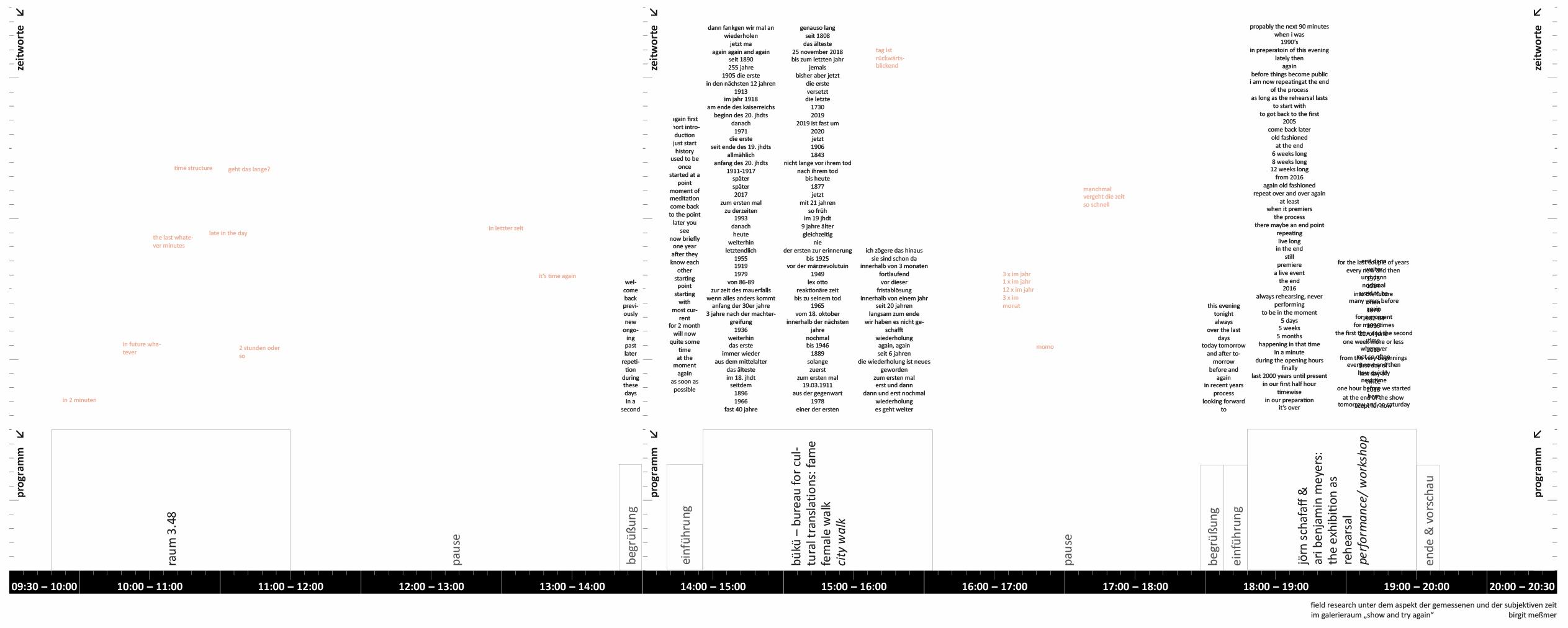
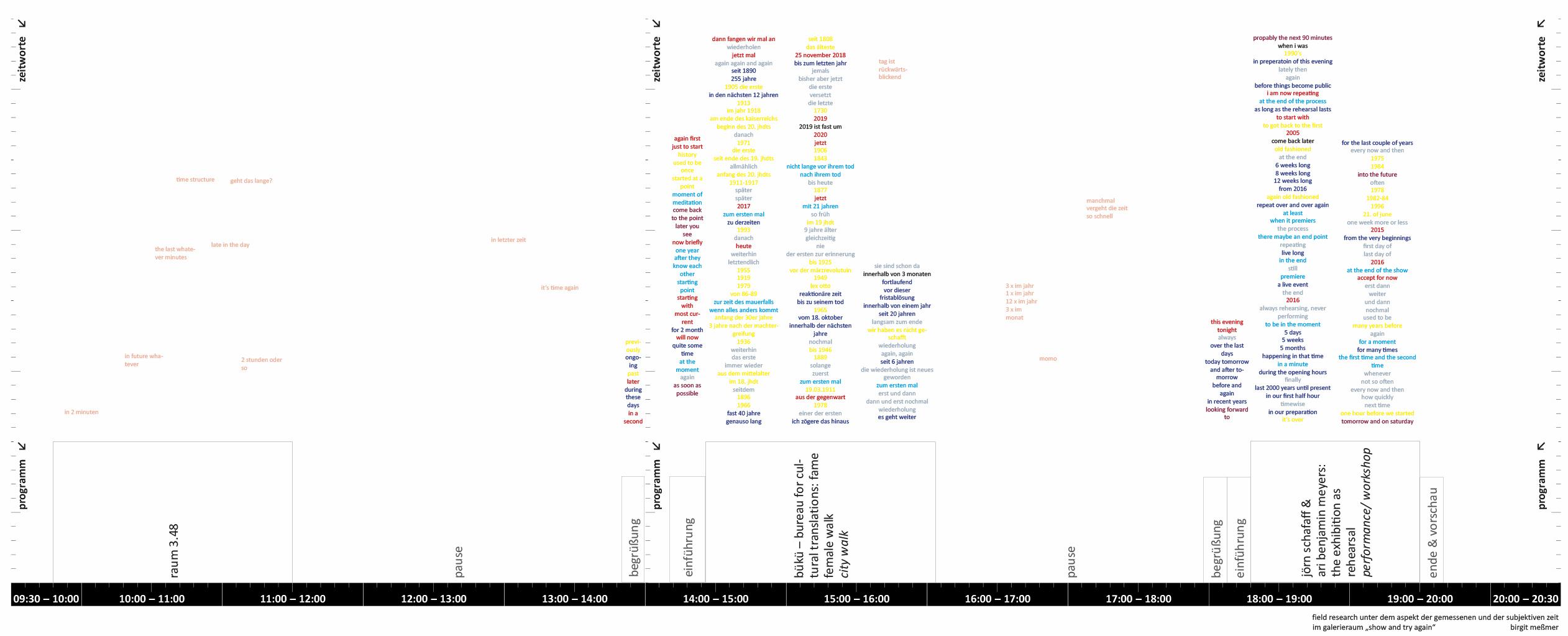
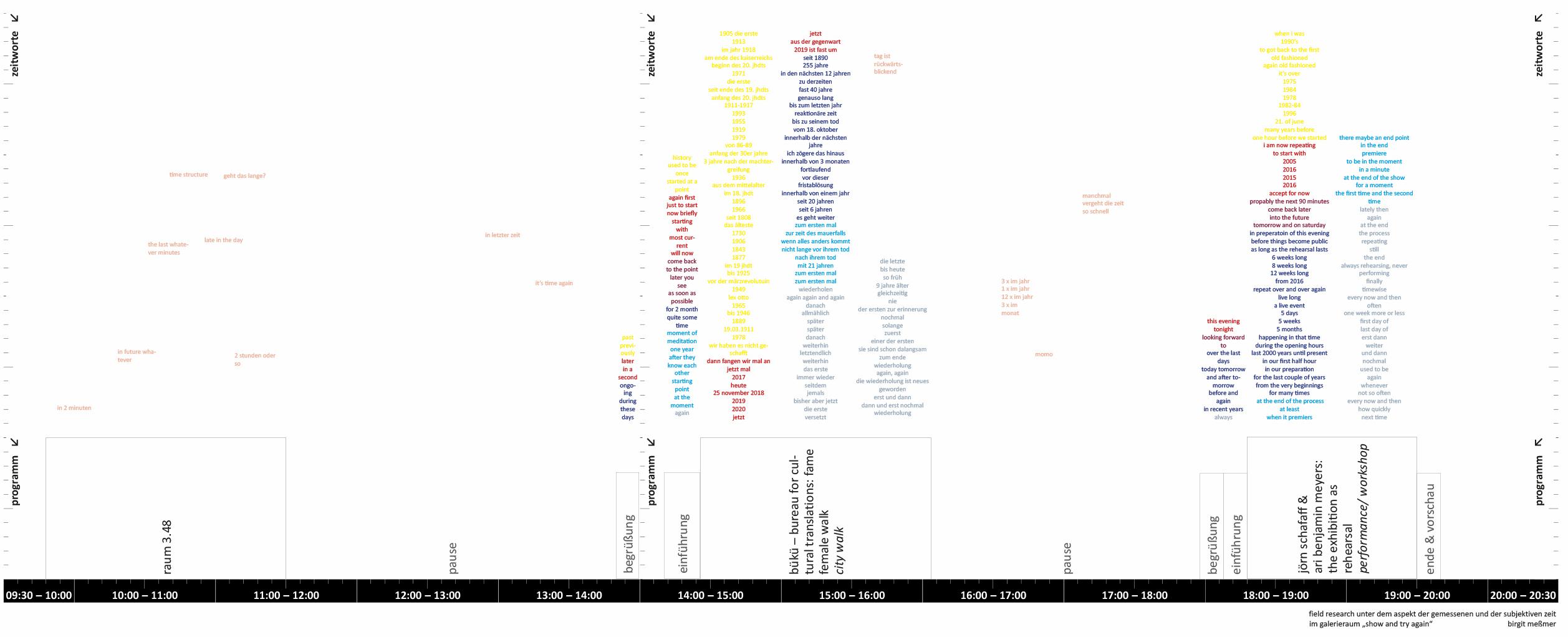
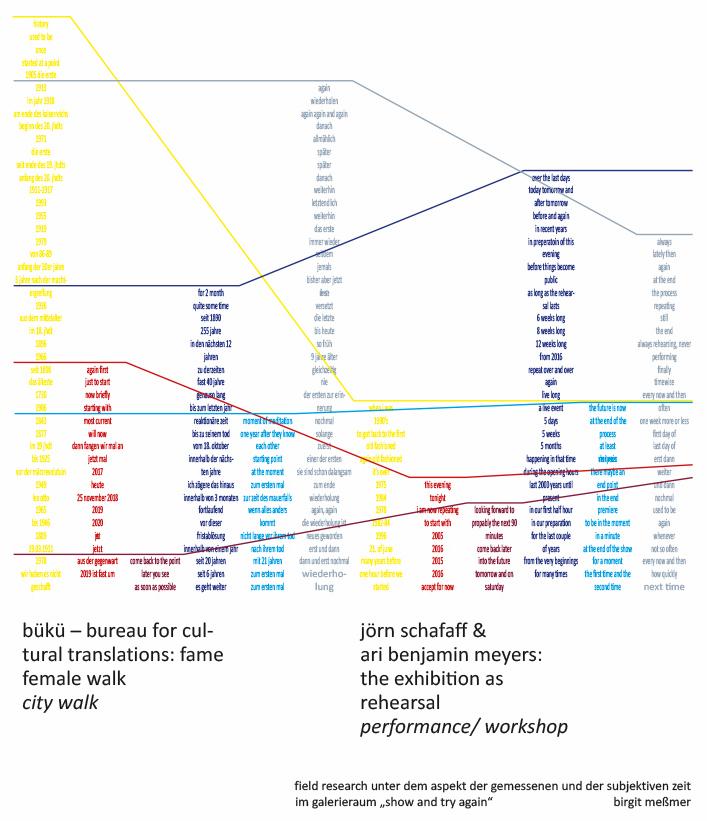
jonas von lenthe
This is the flag of the YPG, the Kurdish Women's Struggle Battalion.
I mean, men generally tend to center themselves and to take on the role of speaker more often.
